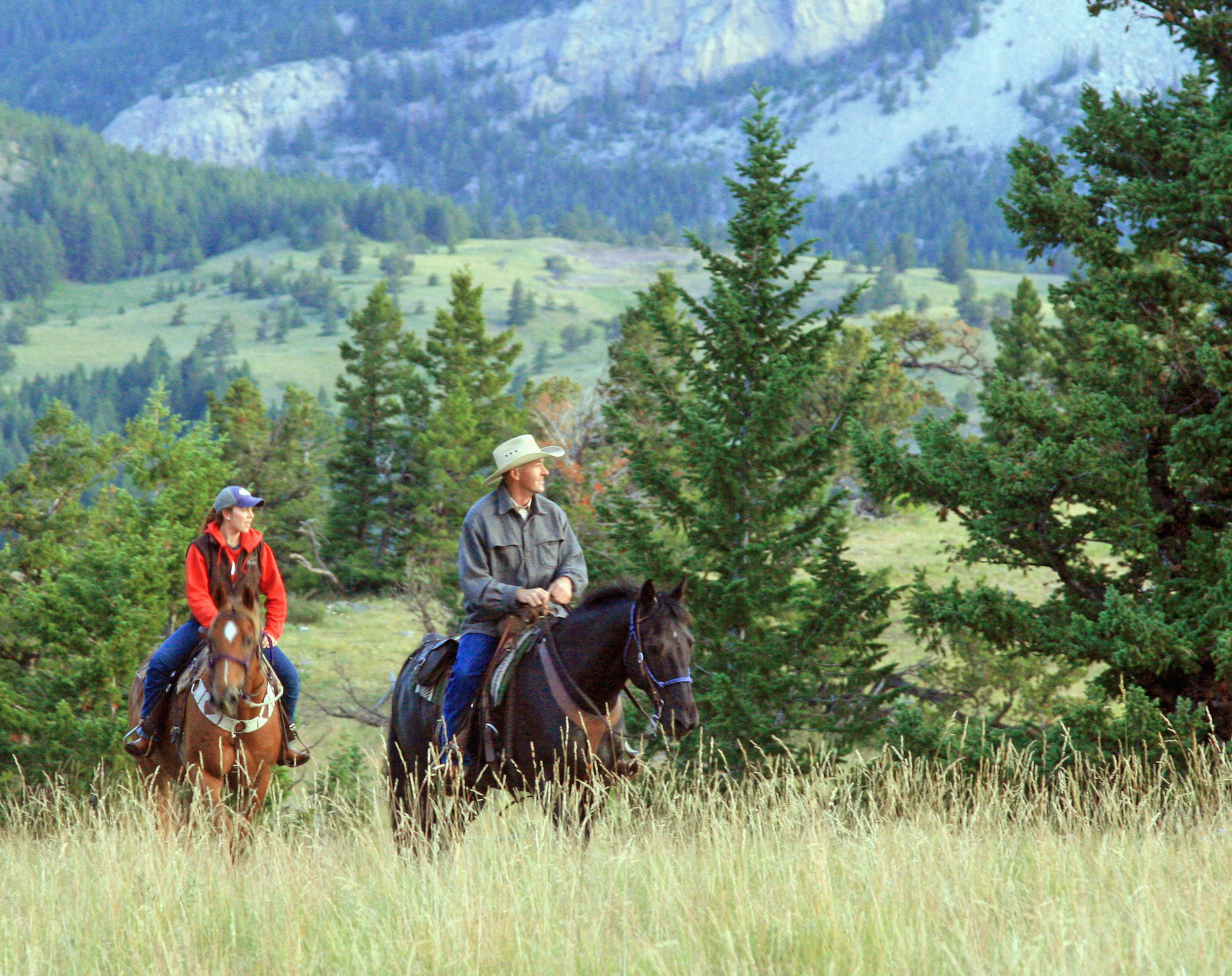
14 Jul The New West
IT’S EARLY JUNE WHEN I HIKE UP INTO THE FOREST that envelops the Pine Butte Guest Ranch, and spring is reluctantly giving way to summer. One moment, it rains, cold and hard. Then sun comes out and warms our fleece-covered bodies as it illumines the petals of the wildflowers making a vivid carpet at our feet. I am walking behind David Cronenwett, the naturalist in residence at Pine Butte, along with a few other guests. We are quiet mostly, absorbing the fascinating facts that David offers, taking in the sights, smells and sounds of this wild and magnificent place. A hawk circles above, screeches. It’s then that I realize, the only other footprints I’ve seen here are bear paws, hooves or claws, not boots. The trails here support more wildlife than people. There are bear scratches, and a tuft of cinnamon-colored fur, on a behemoth Douglas fir. There are moose droppings, fresh, in the middle of the trail. This is their neighborhood, and I am just a visitor. A dude. And a damn lucky one at that.
This place — the Pine Butte Guest Ranch on Montana’s Rocky Mountain Front — provides an exquisitely comfortable and enlightening entrée into one of the most remarkable ecosystems in the Lower 48.
Stretching 150 linear miles across 1.5 million acres, Montana’s Rocky Mountain Front is a geological and biological wonderland, the spectacular amalgamation of jagged limestone peaks and vast, sweeping plains. The interface between these two compellingly different habitats is a diverse environment that is home to more than 290 species of wildlife, including all of the large mammals (with the exception of free-roaming bison) that inhabited the area when Lewis and Clark traveled through more than 200 years ago. As such, the region is considered by biologists to be among the top 1 percent of wildlife habitat in the United States. Numerous organizations — including The Nature Conservancy, the Wilderness Society, U.S. Fish and Wildlife Service and the Rocky Mountain Elk Foundation, among others — have joined forces to protect this extraordinary swath of land from such threats as oil and gas exploration, mining development and even the spread of noxious weeds.
But there is more to the Rocky Mountain Front than mountainous majesty and biodiversity. Indeed there is human heritage dating back 10,000 years to when prehistoric peoples used the spine of the Rockies as a migration route; and there is ranching culture and a way of life in this picturesque corner of the state that are well-worth preserving.
Nestled into a verdant valley beneath flat-topped Indian Head, The Nature Conservancy’s Pine Butte Guest Ranch is committed to sustaining that way of life while protecting the land and its myriad inhabitants.
Set alongside the South Fork of the Teton River, this green oasis was once a Métis settlement. From 1880 to 1930, some 25 families of mixed European and Native American descent lived in the valley, relying on logging and subsistence farming. In 1930, Kenny and Alice Gleason purchased roughly 2,100 acres here and built two log cabins. That same year, the couple welcomed the first guest to their Circle 8 Ranch.
Over the decades, the couple built more cabins on the Circle 8, with Kenny doing everything from harvesting the logs and stacking the stones to building the furniture that would decorate the cabins. Alice taught school nearby and together the Gleasons raised cattle and sheep. To make ends meet, they welcomed guests to the ranch and outfitted hunting trips into the adjacent terrain that today is part of the Bob Marshall Wilderness. Guests arrived from all over the country, including such literary luminaries as Mildred Walker, A.B. Guthrie, and Joseph Kinsey Howard who built a small cabin on the property where he wrote some of Strange Empire, his posthumously published history of the Métis people.
In 1964, the Gleasons were devastated by a 10,000-year flood which destroyed nearly all of the cabins they had spent more than three decades building by hand. Over the next 10 years, the couple rebuilt.
But in 1979, after nearly 50 years at the helm of the Circle 8, the Gleasons sold their guest ranch to The Nature Conservancy, which had opened a field office in Helena the same year. Recognizing the critical importance of the land on which the ranch sits — the Pine Butte Swamp Preserve in particular — and the environment all around it, The Nature Conservancy (TNC) also saw tremendous value in maintaining ranch operations in order to educate guests about conservation.
With a refined vision in place, TNC opened the Pine Butte Guest Ranch to guests in 1986. According to Bebe Crouse, director of communications for TNC’s Montana chapter, this was the era in which so many of Pine Butte’s signature elements — from naturalist programs to gourmet food — came into being.
Today, the Pine Butte Guest Ranch looks like many other ranches that dot the dramatic Rocky Mountain Front. It is a jumble of modest but appealing cabins, and a lovely log and stone lodge where guests gather for meals, slideshows, cocktail parties and any number of rainy-day activities. Across the lawn, a beautiful old barn is the hub for the ranch’s well-known riding program. Guests are paired with a horse for the duration of their stay and can choose from morning, afternoon or all-day rides. They also have the opportunity to ride to various ranch cookouts both for breakfast and dinner. Indeed, the image of a train of horses ambling up the trail into this idyllic setting is a timeless one.
What distinguishes Pine Butte from nearby ranches, where guests are privy to the same age-old traditions and unmatched scenery, is the infusion of TNC values in nearly every aspect of ranch operations. From naturalist-guided hikes to organic produce grown onsite to the widespread use of solar and wind power, Pine Butte Guest Ranch practices the Nature Conservancy’s philosophy of treading lightly on the land and reasserts the belief that education leads to understanding which is the natural forbearer of appreciation. We love what we know, and we protect what we love.
As the ranch naturalist, David Cronenwett guides guests on day hikes and often leads spirited fireside discussions — topics range from grizzly bear recovery to fire ecology to ecologically sound cattle management — over a glass or two of wine in the lodge. “When people know a place, they’re more apt to get involved in conservation efforts,” he offers, matter-of-factly. “We are trying to help people form a relationship with this place.”
That relationship extends right down to the food on every Pine Butte plate. Though the hearty meals are served family style — allowing guests more time to socialize — the creative menus feature fresh organic produce from the ranch’s impressive onsite greenhouse and garden, as well as meat from animals that were raised just a few miles down the road. Cronenwett explains that this unique twist on standard meat-and-potatoes ranch cuisine reflects the ranch’s commitment to “the big picture” of conservation and sustainability.
It is a big picture that clearly appeals to Pine Butte guests, some 65 percent of whom return year after year to this singular dude ranch on the Crown of the Continent. After dinner one evening, TNC state director Kat Imhoff shared with guests her thoughts on the region. “This is an area of the country that a lot of people have realized is critically important for all the remarkable wildlife and plants that still exist here, as well as scenic beauty.” She continued, going on to say what everyone in the lodge that night already knew: “That drive up The Front is maybe one of the best … in the world.”
Dude Ranches: Riding the Range
With such a spectacular setting, it’s no wonder that Pine Butte is not the only ranch tucked into the valleys along Montana’s Rocky Mountain Front. Many other wonderful ranches pay homage to traditional dude ranching. Here are just a few:
MONTANA
Triple J Wilderness Ranch – Augusta: Overlooking the glorious Sun River Canyon, is a marvelous, family-run property that takes advantage of the incredible terrain at the edge of the Bob Marshall Wilderness. The family-friendly ranch offers an excellent kids program, but hosts adult-only weeks as well. The span of activities includes the usual suspects — hiking, fly fishing in their pond, and various games — but the Triple J specializes in horsemanship and guests looking to work on their skills are always satisfied. Half-day and all-day rides are offered daily and the ranch cuisine is just what you’d expect: everything from mouthwatering cinnamon rolls to prime rib and barbecue. (406) 562-3653; www.triplejranch.com
The Seven Lazy P – Choteau: Situated not far from Pine Butte in the heart of Teton Canyon and family owned since 1958, the ranch can accommodate up to 20 guests in a combination of homey cabins and a large guest house. The riding, hiking and fishing opportunities are endless and the ranch is known for their pack trips into the nearby Bob Marshall Wilderness. (406) 466-2044; www.sevenlazyp.com
Mountain Sky Guest Ranch – Emigrant: Decidedly upscale with spa treatments and yoga, gourmet cuisine and a new 9-hole Johnny Miller-designed golf course, the Mountain Sky Guest Ranch is perched high in the mountains above Paradise Valley, just north of Yellowstone National Park. (800) 548-3392; www.mtnsky.com
320 Guest Ranch – Big Sky: With over a century in the dude ranch business, the 320 Ranch is a Big Sky icon. Punctuated by historical roots, hearty meals and honest-to-goodness western hospitality a staying here — summer or winter — is an authentic experience. Horseback riding, hayrides, hiking, skiing, fishing and just a skip into Yellowstone National Park are just some of the perks of the location, but once you settle into the laidback atmosphere you may not want to leave. (800) 243-0320; www.320ranch.com
J Bar L Ranch – Lima: Located in the Centennial Valley, adjacent to Red Rocks Lakes National Wildlife Refuge, this working cattle ranch offers a real-life glimpse into the western lifestyle, with an added twist that encompasses conservation and holistic agricultural practices. In addition to ranch life, J Bar L offers special weeklong Culinary Cowboy cooking workshops hosted by renowned chefs this summer and a Big Sky Photo Adventure week in September. (406) 596-0600; www.jbarl.com
WYOMING
Eatons Ranch – Wolf: Widely considered to be the oldest dude ranch in the world, Eatons is still owned and operated by its founding family in the Big Horn Mountains outside of Sheridan. Its timeless charm includes rustic cabins, family-style meals, and phenomenal unescorted riding opportunities. (307) 655-9285; www.eatonsranch.com
IDAHO
Rider Ranch – Coeur d’Alene: For 20 years this 1,300 acre real working ranch has shared gentle horses for mountainous trail rides, horse drawn hayrides and evening dinner rides. It’s the perfect place for a wedding or family reunion. (208) 667-3373; www.riderranch.com
- Ready for the open range. Photo by Will Brewster
- Horseback riding on the ranch’s good natured mounts is offered daily. Photo by Simon Williams
- Pine Butte offers cookouts twice daily. Photo by Simon Williams
- Spring and fall natural history workshops — including birding with renowned artist and ornithologist David Sibley — combine hands-on learning in the field with enriching evening talks and photo presentations. Photo by Simon Williams
- The inviting cabins were built from local wood and stone and many of them are outfitted with furniture hand-made by the Gleasons. Photo by Bebe Crouse
- Eleven cabins on the ranch have their own unique charm and a cozy fireplace to boot. Photo by Kenton Rowe





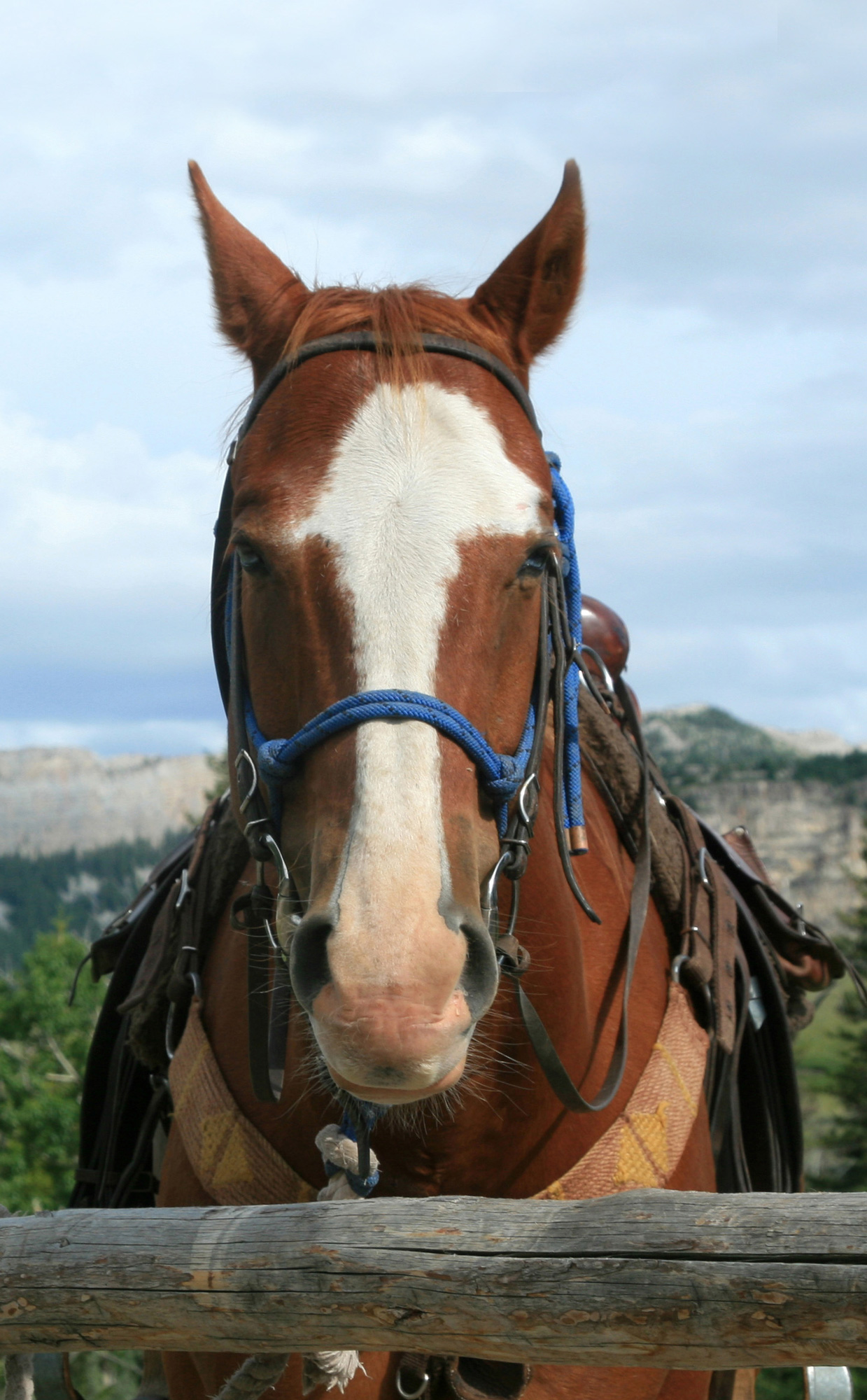
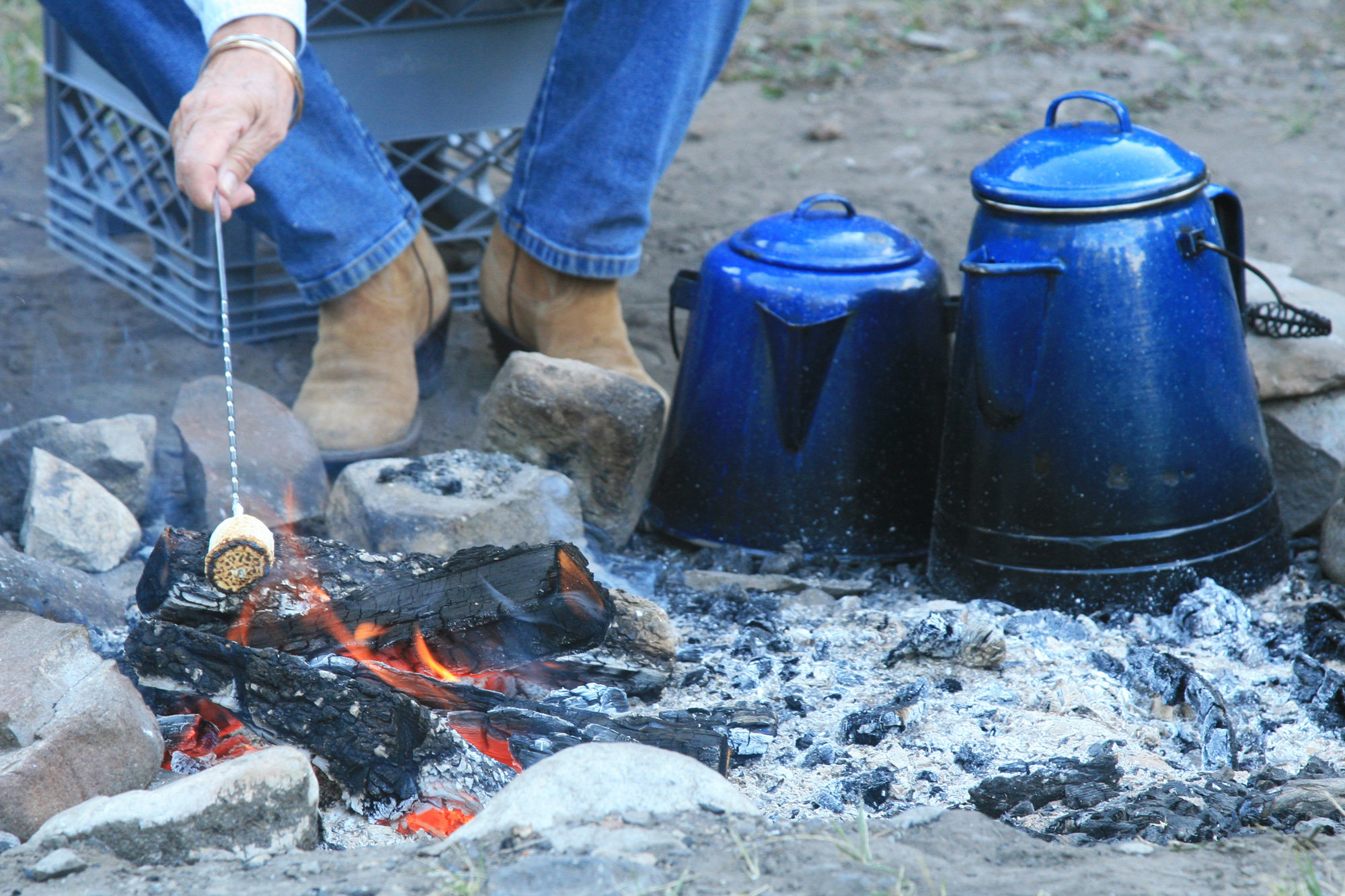
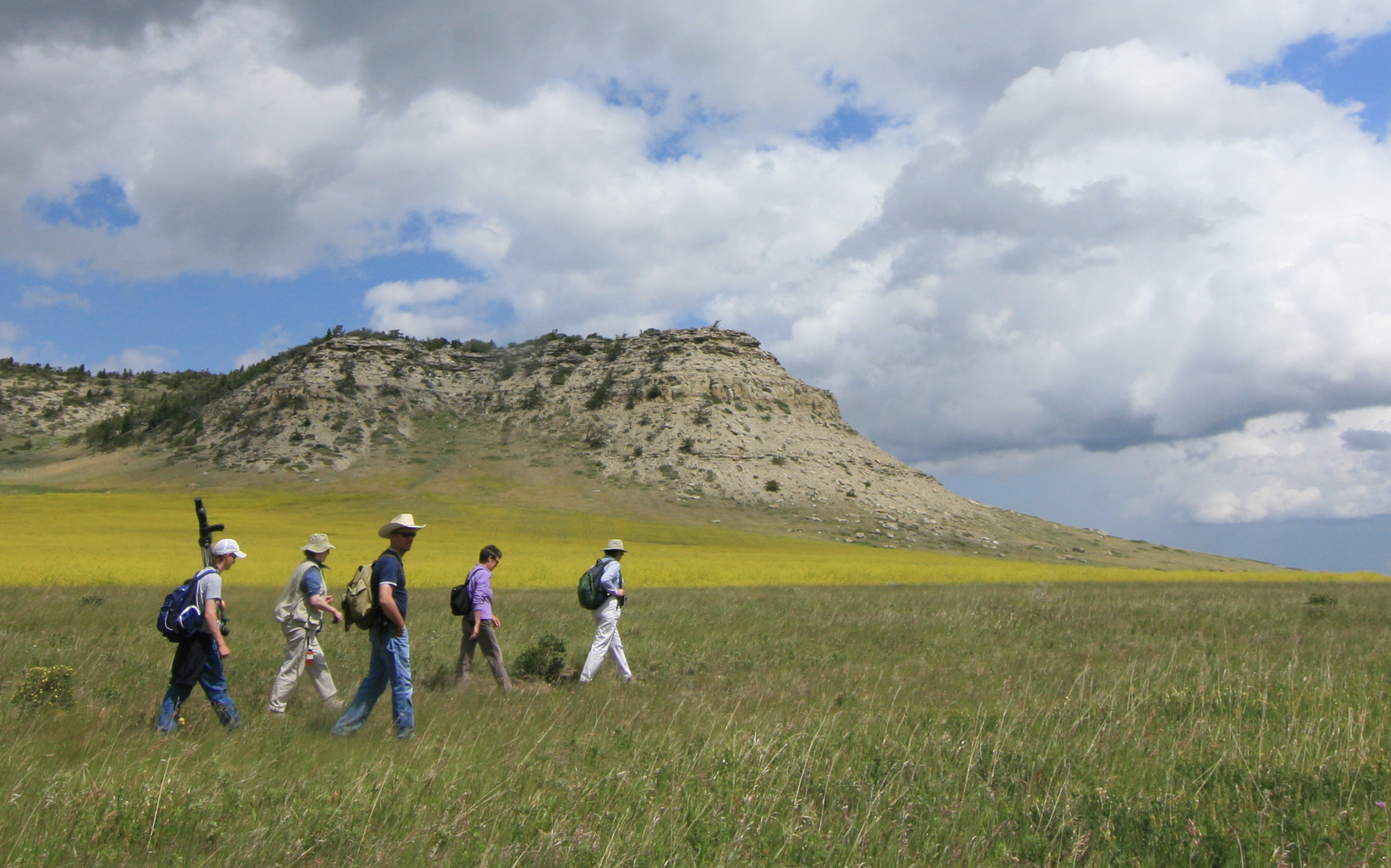

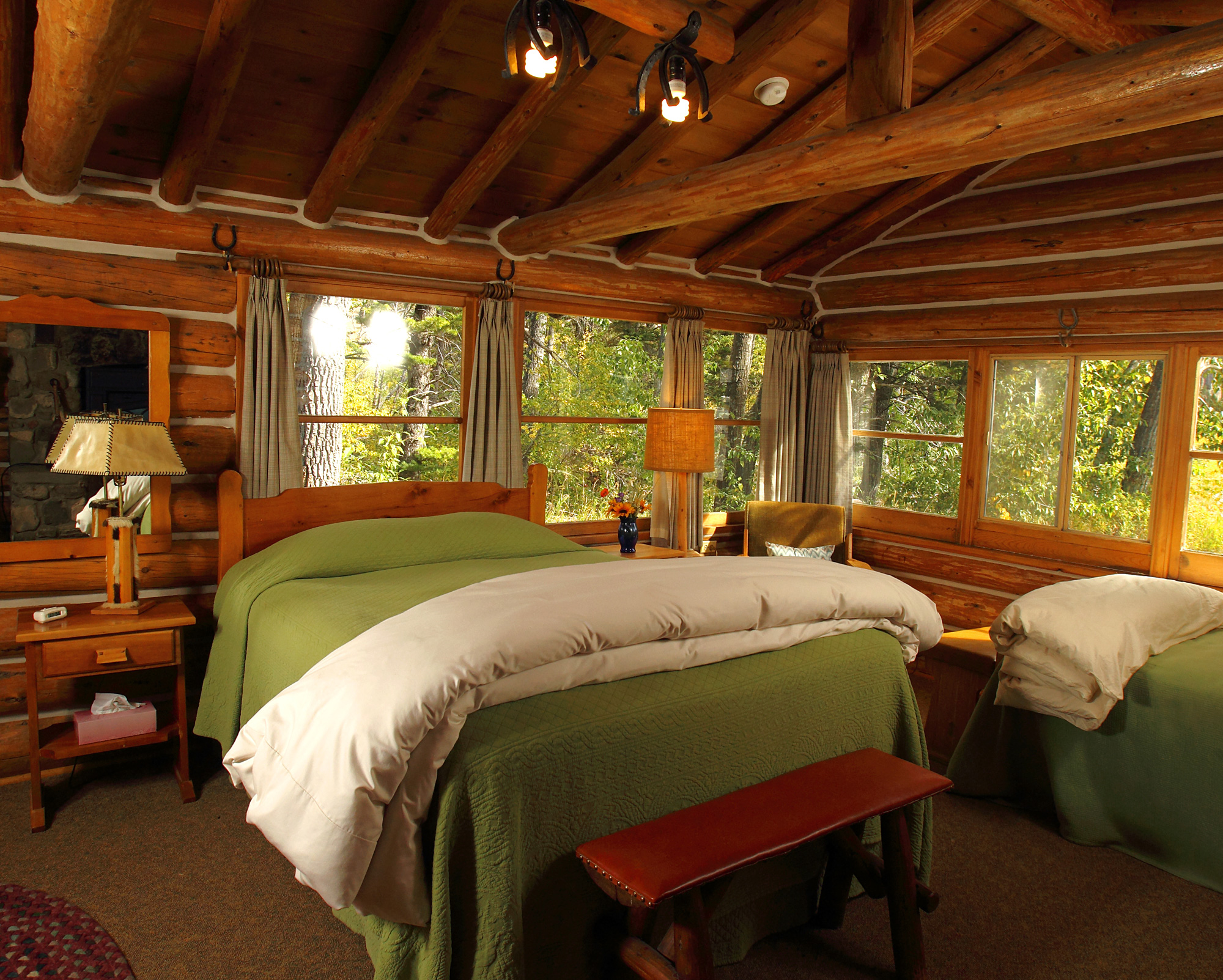
No Comments